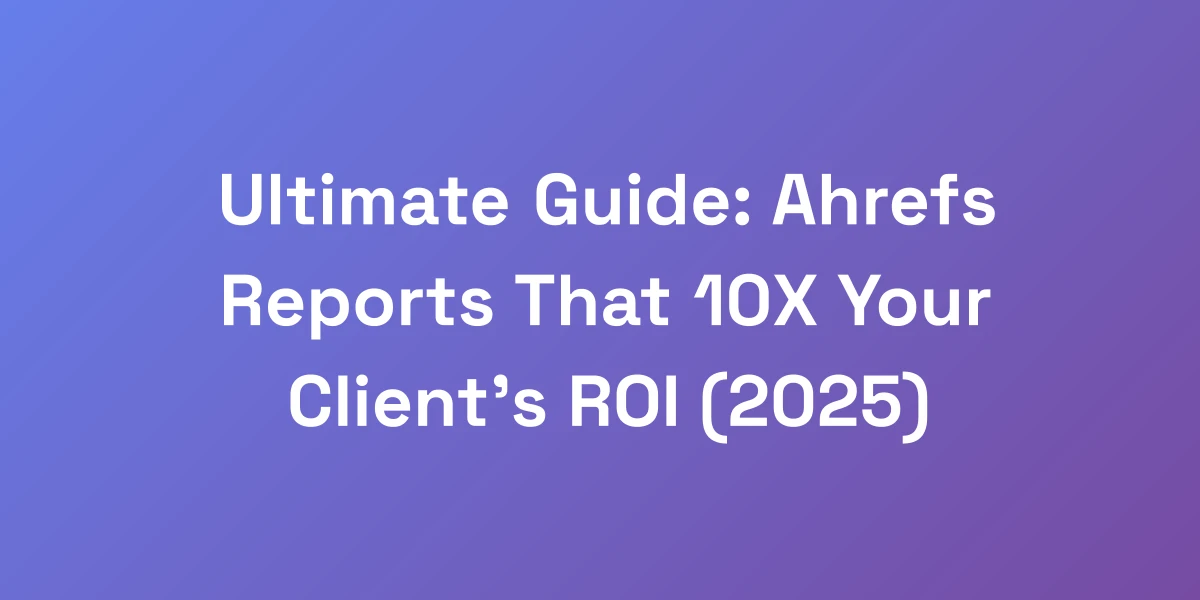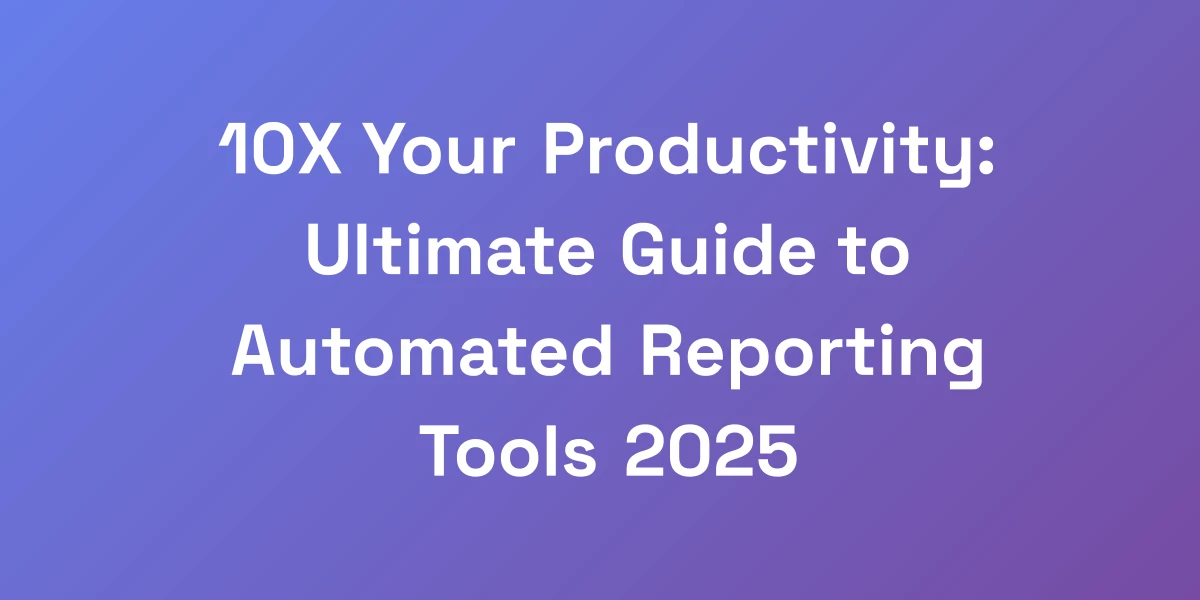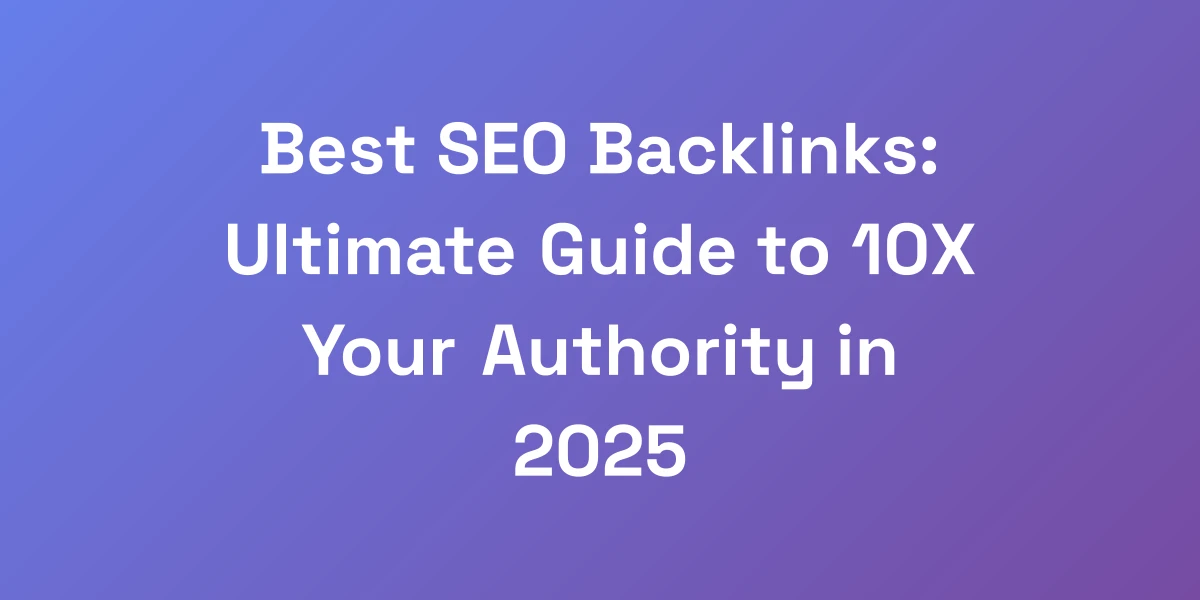
Monthly SEO Reporting That 10X Your Client Retention (2025 Guide)
Mar 17, 2025 | By [email protected]
Introduction
Let’s cut to the chase: monthly SEO reporting can make or break your client relationships.
Imagine handing over a report that doesn’t just list numbers, but tells a compelling story of growth and impact. It’s not just about metrics; it’s about showing your clients the real business value.
Too many agencies fail because their reports are dry and disconnected from what clients truly care about. We’re here to change that.
Ready to transform your reporting process into a client retention powerhouse? Let’s dive in and build a strategy that not only impresses but retains your clients for the long haul.
Why Most SEO Reports Fail to Retain Clients (And How to Fix It)
Let me hit you with some truth: 80% of SEO reports are garbage. They’re data dumps that make clients’ eyes glaze over faster than a PowerPoint presentation at 4 PM on a Friday.
Here’s the thing – your monthly SEO reporting isn’t just about showing numbers; it’s about telling a story that justifies your retainer.
When we scaled our agency to 8-figures, we discovered that the difference between losing clients and keeping them for years came down to one thing: translating SEO metrics into business impact.
Let’s fix your reporting strategy and turn it into a client retention machine. Understanding the average customer retention rate by industry can provide valuable benchmarks to assess and improve your own retention strategies.
The Psychology Behind Effective Client Communication
Understanding your client’s mindset is crucial. Clients want to feel understood and assured that their investment is yielding results.
We tap into psychological triggers by presenting data in a way that aligns with their goals and pain points.
Ask yourself: Are you speaking their language? Are you addressing their core concerns?
By doing so, you build trust and demonstrate empathy, making your reports not just informative but also reassuring.
Common Reporting Mistakes That Kill Client Trust
Here’s what typically goes wrong:
- Overwhelming Data: Bombarding clients with too many metrics can lead to confusion and disengagement.
- Lack of Context: Presenting numbers without explaining their significance leaves clients in the dark.
- Inconsistent Reporting: Irregular reports create uncertainty and mistrust.
These mistakes undermine the value you provide and erode client confidence.
We avoid these pitfalls by focusing on clarity, relevance, and consistency in our reporting. Implementing SEO reporting best practices ensures that your reports are both effective and appreciated.
The Business Impact Framework for SEO Reporting
To make your reports truly impactful, adopt a Business Impact Framework. This means aligning SEO metrics directly with your client’s business goals.
Start by identifying key business objectives, then map your SEO efforts to these goals.
For example, if a client’s goal is to increase online sales, focus on metrics like organic traffic, conversion rates, and revenue growth.
This approach ensures that every piece of data you present is directly tied to the client’s bottom line.
How to Present Data That Actually Matters to Decision Makers
Decision makers are busy. They need concise, relevant information that can drive action.
Here’s how to make your data matter:
- Highlight Key Metrics: Focus on KPIs that align with business goals.
- Use Visuals: Charts and graphs make data easier to digest and more impactful.
- Provide Insights: Don’t just show the data. Explain what it means and how it impacts their business.
By focusing on what truly matters, you make your reports not just informative but also actionable.
Case Study: From 30% to 95% Client Retention Through Better Reporting
We took a client retention rate of 30% and skyrocketed it to 95% by revamping our reporting strategy.
How? We shifted from generic data dumps to tailored reports that showcased the direct business impact of our SEO efforts.
By focusing on metrics that mattered to the client’s revenue and using visuals to tell a compelling story, we built trust and demonstrated undeniable value.
This transformation wasn’t just about better reports; it was about fostering stronger, more transparent relationships.
Building Your Monthly SEO Report Template That Sells Results
Stop copying those generic templates floating around the internet. Your SEO report needs to be a weapon of mass persuasion.
I’m going to show you how to structure your monthly reports to demonstrate value so clearly that clients will fight to keep you.
The key is building a template that focuses on what I call the “Money Metrics” – the numbers that directly correlate with your client’s revenue goals.
When you align your reporting with their business objectives, you transform from a vendor into a strategic partner they can’t afford to lose.
The 5-Part Template That Never Fails
Your report should be structured into five key sections:
- Executive Summary: A high-level overview of key achievements and insights.
- Performance Metrics: Detailed data on critical SEO metrics tied to business goals.
- Actionable Insights: Analysis of data and strategic recommendations.
- Future Strategies: Plans for the upcoming period to drive continued growth.
- Client Feedback: A section for client input and questions to foster two-way communication.
This structure ensures that your report is comprehensive yet focused, providing everything the client needs to understand and value your work. Learn how to create an SEO report that adheres to these essential components.
Essential KPIs That Actually Matter to Business Owners
Focusing on the right KPIs is crucial. Here are the essentials:
- Organic Traffic: The volume of visitors coming from search engines.
- Keyword Rankings: Positions of targeted keywords in search results.
- Conversion Rates: The percentage of visitors taking desired actions.
- Revenue Growth: Direct impact of SEO efforts on sales and revenue.
- Backlink Quality: The authority and relevance of sites linking to the client’s website.
These KPIs provide a clear picture of how SEO efforts translate into tangible business outcomes.
By emphasizing metrics like conversion rate benchmarks, you align your reporting with what business owners care about the most.
Visualizing Data for Maximum Impact
A picture is worth a thousand words, especially in reporting.
Use visuals like charts, graphs, and infographics to present data in an engaging and understandable way.
Visuals help highlight trends, compare performance over time, and make complex data accessible at a glance.
For example, a line graph showing organic traffic growth month-over-month can instantly convey upward momentum without the need for extensive explanations.
Incorporate interactive elements where possible to allow clients to explore data further. The use of data visualization in image search SEO is becoming increasingly significant, enhancing the clarity and impact of your reports.
Automated vs. Manual Reporting: When to Use Each
Automation is a game-changer, but it’s not a one-size-fits-all solution.
Here’s when to automate and when to handle things manually:
- Automate: Routine data collection and standard report generation to save time and ensure consistency.
- Manual: Custom analysis, personalized insights, and strategic recommendations that require a human touch.
By striking the right balance, you can scale your reporting process without sacrificing quality.
Automate the repetitive tasks, and focus your expertise on delivering value where it matters most.
Customization Strategies for Different Industries
Every industry has its unique metrics and priorities.
Your reporting should reflect this diversity by tailoring the content to each client’s specific needs.
For instance:
- E-commerce: Focus on conversion rates, product page rankings, and revenue growth.
- B2B Services: Highlight lead generation, keyword rankings for industry terms, and website authority.
- Local Businesses: Emphasize local search rankings, Google My Business metrics, and customer reviews.
Understanding the distinct drivers of success in each industry allows you to present relevant data that resonates with your clients’ business goals. Refer to the SEO benchmarks by industry to tailor your reports effectively.
Advanced Client Communication Strategies in SEO Reporting
Here’s what nobody tells you about SEO reporting: it’s 20% data and 80% communication.
The agencies crushing it right now aren’t necessarily doing better SEO – they’re just better at communicating their value.
We’re sharing the exact communication framework we used to increase our average client lifetime value by 300%. It’s all about creating what I call “Anticipatory Reporting” – addressing concerns before they become objections and turning potential cancellation points into opportunities for upsells.
Let’s break down these advanced strategies to elevate your client communication.
The “Value-First” Presentation Method
Start every report by highlighting the value you’ve delivered, not just the activities you’ve performed.
- Showcase Achievements: Begin with key successes that align with the client’s goals.
- Impact Over Activity: Focus on how your SEO efforts have directly impacted their business metrics.
This method ensures that clients immediately see the worth of your services, setting a positive tone for the rest of the report.
Handling Negative Results Without Losing Trust
Not every month will be filled with stellar results, and that’s okay.
When faced with negative results, transparency and strategy are your allies.
- Be Honest: Acknowledge setbacks without sugarcoating.
- Provide Context: Explain the factors contributing to the negative results.
- Present a Plan: Outline clear steps you’ll take to address the issues and improve performance.
By handling negative results with honesty and a proactive approach, you maintain trust and demonstrate your commitment to continuous improvement.
Using Reports to Upsell Additional Services
Your reports can be a powerful tool for identifying and presenting upsell opportunities.
Here’s how:
- Identify Gaps: Highlight areas where additional services could drive further growth.
- Provide Solutions: Suggest specific services that address these gaps.
- Demonstrate Value: Show how these additional services can enhance the current results.
This approach not only increases your revenue but also deepens your role as a strategic partner in your client’s success.
Client Education Through Strategic Reporting
Educated clients are loyal clients. Use your reports to educate clients about SEO strategies and their importance.
Include sections that explain the reasoning behind your strategies, the significance of certain metrics, and how different SEO tactics work together.
Empowering your clients with knowledge fosters trust and positions you as an expert, making them more likely to stick with your services long-term.
Building Long-term Client Relationships Through Data
Consistent, transparent, and insightful reporting lays the foundation for long-term relationships.
Here’s how data helps:
- Transparency: Regular updates keep clients informed and involved.
- Accountability: Clear data holds both parties accountable for progress and results.
- Engagement: Interactive and meaningful data presentations keep clients engaged and invested.
By leveraging data effectively, you build strong, enduring relationships that withstand market changes and evolving client needs.
Automating Your SEO Reporting Process for Scale
Want to know what kills most agencies? It’s spending 15 hours per month per client on reporting. That’s insane.
We automated 90% of our reporting process while actually improving report quality.
The secret is what I call “Intelligent Automation” – combining automated data collection with strategic human analysis.
This system allowed us to scale from 10 to 100 clients without hiring a single additional report writer. Let us show you how to build a reporting machine that scales.
Tools and Software for Automated Reporting
Choosing the right tools is the first step towards automation.
- AgencyAnalytics: Integrates seamlessly with Google Analytics and Google Search Console, providing comprehensive data in one place.
- Databox: Offers customizable dashboards that can pull data from multiple sources, making it easier to visualize key metrics.
- Databox: Enables the creation of interactive reports that clients can explore on their own.
Investing in robust SEO reporting tools like what to include in an SEO report saves time and ensures consistency across all your reports.
For those looking to enhance their reporting efficiency, consider exploring automated SEO optimization solutions to further streamline your processes.
Creating Templates That Scale
Templates are the backbone of efficient reporting.
Develop standard templates that can be easily customized for each client’s specific needs.
- Modular Design: Create sections that can be added or removed based on client requirements.
- Consistent Layout: Maintain a uniform structure to make report generation faster and more reliable.
- Automated Data Integration: Link your template to reporting tools to automatically populate data.
This approach ensures that you can produce high-quality reports quickly, even as your client base grows.
Additionally, leveraging auto SEO tools can further enhance your template’s effectiveness by automating repetitive tasks.
Quality Control in Automated Reports
Automation shouldn’t compromise quality.
Implement quality control measures to ensure the accuracy and relevance of your reports.
- Regular Audits: Periodically review automated reports for errors and inconsistencies.
- Manual Spot Checks: Randomly check sections of automated reports to ensure they meet your standards.
- Client Feedback: Encourage clients to provide feedback on report quality and make adjustments accordingly.
Maintaining high standards through quality control ensures that your reports remain reliable and valuable.
The Human Touch: What Not to Automate
While automation handles data collection and basic reporting, certain elements require a personal touch.
- Strategic Insights: Automated reports can’t replace the nuanced analysis and strategic recommendations provided by human expertise.
- Customization: Tailoring reports to fit the unique needs and preferences of each client often requires manual adjustments.
- Client Communication: Building relationships and understanding client nuances can’t be automated.
By focusing automation on repetitive tasks and reserving strategic elements for human intervention, you maintain a balance between efficiency and personalization.
ROI of Reporting Automation
Automating your reporting process isn’t just about saving time—it’s about maximizing ROI.
Here’s how:
- Increased Efficiency: Reduce the time spent on manual report generation, allowing you to handle more clients without additional resources.
- Consistency: Ensure all reports meet a high standard of quality, enhancing client trust and satisfaction.
- Scalability: Easily scale your reporting process as your client base grows, without compromising on quality or turnaround time.
Investing in automation tools and processes can significantly boost your agency’s profitability and growth potential.
For small businesses seeking affordable SEO services, incorporating automated solutions ensures you deliver high-quality reports without breaking the bank.
Turning Monthly SEO Reports Into Sales Tools
Most agencies see reporting as an obligation. Smart agencies see it as an opportunity.
We’re going to teach you how to turn your monthly SEO reports into sales machines that generate referrals.
We used this exact system to generate 47% of our new business from existing client referrals.
The key is understanding that every report is a marketing piece for your agency. When done right, your monthly reporting becomes your most powerful sales tool.
Let’s explore how to leverage your reports for unstoppable growth.
Building Social Proof Into Reports
Social proof is a powerful tool in building credibility and trust.
Incorporate testimonials, case studies, and success stories directly into your reports.
- Client Testimonials: Feature positive quotes from satisfied clients to reinforce your agency’s value.
- Case Studies: Highlight specific projects where your SEO strategies led to significant results.
- Success Metrics: Showcase key performance indicators that demonstrate your impact.
This not only reinforces the value you provide but also encourages clients to share their own positive experiences.
Creating Referral Triggers in Your Reports
Strategically design your reports to encourage referrals.
Here’s how:
- Highlight Achievements: When clients see clear, impactful results, they’re more likely to refer others.
- Include Shareable Content: Provide sections of the report that clients can easily share with their networks, such as key metrics or infographics.
- Call to Action: End your reports with a subtle prompt encouraging clients to refer your services to others.
By embedding referral triggers, you turn each report into a potential lead generator.
Using Reports for Case Studies
Your monthly reports are a goldmine for creating compelling case studies.
Here’s the process:
- Identify Success Stories: Look for clients who have achieved significant milestones through your SEO efforts.
- Gather Data: Use the data from your reports to showcase before-and-after scenarios.
- Craft the Narrative: Develop a story that highlights the challenges, strategies, and results.
These case studies serve as powerful testimonials of your expertise, making it easier to attract new clients.
The “Next Steps” Framework
Every report should outline clear next steps, guiding clients towards further engagement.
Here’s how to implement the “Next Steps” framework:
- Identify Opportunities: Highlight areas where additional SEO strategies can drive more results.
- Propose Solutions: Suggest specific services or actions that can capitalize on these opportunities.
- Set Goals: Define clear, measurable objectives for the next reporting period.
This framework not only shows your proactive approach but also opens doors for upselling additional services.
Measuring Report Effectiveness for Sales
To ensure your reports are driving sales, you need to measure their effectiveness.
Here’s how:
- Track Referrals: Monitor how many new clients come from existing client referrals.
- Analyze Feedback: Collect and analyze client feedback on report clarity, usefulness, and impact.
- Evaluate Engagement: Measure how often clients interact with different sections of the report, such as clicking on interactive elements or providing feedback.
By tracking these metrics, you can continuously refine your reporting strategy to maximize its impact on sales.
Conclusion
Mastering monthly SEO reporting is your gateway to unparalleled client retention and business growth.
By transforming your reports from mere data dumps into strategic, value-driven narratives, you not only demonstrate your expertise but also solidify your role as an indispensable partner.
Remember, it’s not just about the numbers; it’s about the story those numbers tell and the tangible business impact they represent.
So, take the insights and strategies we’ve covered, implement them with precision, and watch your client retention rates soar.
Ready to elevate your SEO reporting and retain clients like never before? Start today and transform your reports into your most powerful business tool.
What strategies have you found effective in your monthly SEO reporting? Share your thoughts and experiences in the comments below—we’d love to hear from you!
For agencies looking to enhance their SEO capabilities, exploring auto SEO software can provide the necessary tools to streamline and optimize your reporting processes.
![Monthly SEO Report Template That 10X Your Client Retention [2025]](https://autoseo.eazyseo.co/wp-content/uploads/2025/03/Monthly-SEO-Report-Template-That-10X-Your-Client-R.webp)







